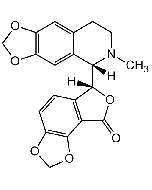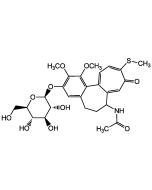Cookie Policy: This site uses cookies to improve your experience. You can find out more about our use of cookies in our Privacy Policy. By continuing to browse this site you agree to our use of cookies.
Chemodex
Bifenazate

| Product Details | |
|---|---|
| Synonyms | Floramite; Isopropyl 2-(4-methoxy-3-biphenylyl)hydrazinecarboxylate; 1-Methylethyl 2-(4-methoxybiphenyl-3-yl)hydrazinecarboxylate |
| Product Type | Chemical |
| Properties | |
| Formula | C17H20N2O3 |
| MW | 300.35 |
| CAS | 149877-41-8 |
| Source/Host Chemicals | Synthetic. |
| Purity Chemicals | ≥99% (HPLC) |
| Appearance | White solid. |
| Identity | Determined by NMR. |
| Declaration | Manufactured by Chemodex. |
| Other Product Data |
Click here for Original Manufacturer Product Datasheet |
| InChi Key | VHLKTXFWDRXILV-UHFFFAOYSA-N |
| Smiles | COC1=C(NNC(=O)OC(C)C)C=C(C=C1)C1=CC=CC=C1 |
| Shipping and Handling | |
| Shipping | AMBIENT |
| Short Term Storage | +20°C |
| Long Term Storage | +4°C |
| Handling Advice |
Keep cool and dry. Protect from light and moisture. |
| Use/Stability | Stable for at least 2 years after receipt when stored at +4°C. |
| Documents | |
| MSDS |
 Download PDF Download PDF |
| Product Specification Sheet | |
| Datasheet |
 Download PDF Download PDF |
Bifenazate is a contact acaricide active against adult, eggs and nymphal life stages of spider, red and grass mites. It has a rapid knockdown effect (usually less than 3 days) and residual activity on the leaf lasting up to 4 weeks. It is suggested to act as a GABA (γ-aminobutyric acid) antagonist in the peripheral nervous system at the neuromuscular synapse in insects. It blocks the GABA-activated chloride channels, resulting in overexcitation of the peripheral nervous systems of susceptible pests. This mode of action is reported to be unique among acaricides, which suggests the product could play an important future role in mite resistance management strategies. It is safe to sensitive flower parts and does not cause phyto-toxicity. Can be used as a reference compound.
(1) M.A. Dekeyser; Pest. Manag. Sci. 61, 103 (2005) | (2) E.M. Rhodes, et al.; Exp. appl. Acarol. 39, 213 (2006) | (3) T. Van Leeuwen, et al.; Pest. Manag. Sci. 63, 1172 (2007) | (4) S. Hiragaki, et al.; Neurotoxicol. 33, 307 (2012)










